|
|
 |
|||||||||
|
Volume 13, Issue 22 ~ June 2 - 8, 2005
|
||||||||||
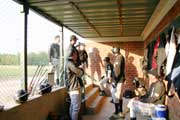 The Older Boys of Summer The Older Boys of SummerFinding happiness is simple on this field of dreams story & photos by Scott Sowers Joe Cannon Stadium at Harmans Park sits near the intersection of routes 100 and 713, just east of the Arundel Mills Mall. Sitting in the stands, you can hear the white hiss of traffic noise from I-295 mixed in with the sounds of jets climbing out of BWI. You can also hear the ping of aluminum bats from the batting cage, the thwack of hard balls hitting gloves and the sound of cleats scraping against the concrete floors in the dugouts. This is a well-maintained little stadium with a concession stand, press box and an electronic scoreboard. Filled to capacity, it holds 1,500 fans. But for tonight’s game between the Indians and the White Sox, the official attendance is four. As in four people. Welcome to the world of adult amateur baseball. This isn’t the minors, the pony leagues or anything too official. But if you’re a man over 38 years old and want to play baseball, meaning hard ball, it’s possible to come to a place like Joe Cannon and have 20 other guys show up in full uniform at the same time with the same idea in mind. At 6:30pm on a Wednesday, pickup trucks and family sedans start pulling into the parking lot as guys get out and head to the stadium carrying large equipment bags. They’re already dressed for baseball, having changed at home, at work or somewhere in between. Their shoulders are stooped and some of their gaits show a bit of limp, but they are smiling and laughing as they make their way to the dugouts. Happy men going to play baseball. Play Ball They do some stretching, take batting practice and play catch before the umpire yells Play ball! to start the game promptly at 7:02. The Indians jump on top early by knocking in a run in the first inning. There isn’t much pageantry at Harmans Park tonight, but the game is still the game. There’s spitting, sliding, stealing and arguing with the ump. There’s stand-up doubles, jammed fingers and nicked knees. There’s trash talk in the dugouts, high fives and chatter from the infield. There’s fouled balls, thrown bats, line shots up the middle, choppers down the third-base line and unforced errors. But mostly there’s the kind of fun that only happens when a group of grown men get together and put on uniforms. This is not a fantasy camp or a once-a-year occasion. It’s a Men’s Senior Baseball League game that’s part of a season that stretches from May to August. At least among players, it’s a game popular enough to support two nationwide leagues and a third regional league. In the second inning, last year’s Anne Arundel league champion White Sox comes back to even the score. Shouts of joy bellow from faces lined with age under caps sprouting gray hair. Bellies push against waist bands, and the letters on the Sox uniforms are peeling off. Despite how they look, these guys are the champs, and they have the title to prove it. The Indians’ uniforms look newer and cleaner. These Indians are managed by Drew Smith who’s 57 and a business broker from Annapolis. His shouts from the dugout door betray a history of coaching Little League. His eyes flit between his pitcher working the mound to his score sheet as he talks about what’s going on besides the competition. “The friendship goes beyond the guys on the team,” Smith says. “They like each other. There’s a bond, and the bond goes beyond teammates.” Smith took over management duties when the guy who used to do it dropped out. “Nobody else wanted to do it,” he says. “The hard work was mostly done. These guys coach themselves.” When the Indians starter tires, Glenn Dubkowski, 44, will get the call. A configuration manager for Northrop Grumman, Dubkowski is also a relief pitcher for the White Sox. When he’s called in to seal the deal, it won’t be till sometime after the seventh. In the meantime, he waits and watches. Dubkowski is here because he chose to be. After playing on other teams for a few years, he lobbied to get on the White Sox because he knew they were competitive. But it’s actually a minor miracle that he’s playing at all. While pitching in a game two years ago he broke his arm after throwing a pitch, a freak accident that’s never supposed to happen. “I heard it,” Dubkowski says. “It snapped like you were breaking a stick.” Dubkowski’s girlfriend talked him into going back to the mound. Now he’s rehabilitated, “having a good time and striking everybody out.”
By the third inning, it’s gotten dark and the lights are warming to life overhead. The guys in the dugout turn into shadows and silhouettes. Ghosts playing for a grandstand full of nobody. Strategies about pitching and hitting bounce off the cinderblock walls as the managers read over the roster and scratch their heads. “You can rattle this guy’s chain,” says a voice. “He’s got no arm,” another chimes in. Here in the twilight of a fading day, they’re still out there — looking for an edge, looking for a win, looking for a way to stave off the day when the legs refuse to run and the arm refuses to throw. Gary Shay, 47, plays pitcher, shortstop and third base for the White Sox. He’s a UPS guy with arthritic hands and a wiry body that comes from a couple of decades of beefing boxes for a living. He’s been playing for the White Sox for six years, and he’s the loudest guy in the dugout. “I love the guys on the team,” he says, “I’ve been on a lot of teams, and this one’s the best.” Players get into the game in a variety of ways including a pre-season draft. But most guys get on a team because they know somebody or somebody knows them. Good chemistry is crucial. “We’ll have a guy come out and practice,” Drew Smith, says. “If it’s a good fit, great. But we don’t want a guy stirring stuff up.” There’s no patience for prima donnas here, and there’s no time to waste on attitudes. Top of the Fourth The top of the fourth brings a still-knotted tie and a rotation of players. Every couple of innings, guys come in and guys come out so everybody gets to play. Teams carry the standard nine players and a couple of reserves. While players ride the bench, they keep score and offer a steady stream of razz and encouragement to their teammates. Practices are kept to a minimum. There’s general pre-season sessions, and if there’s a long stretch between games a manager may call for a practice just to keep everybody sharp — as sharp as they can be. Rex Little is a 43-year-old marketing pro from Largo who plays first base for the Indians. He wears number 44 in honor of Hank Aaron and is the most vocal guy on the Tribe’s side of the field. Little would like to have more free time devoted to the practice field. “We don’t get a lot of BP [batting practice] in,” he says. “So the lack of opportunity to hone our skills makes it hard to be consistent.” The players talk about places to go with batting cages. Places next to miniature golf courses where families with kids show up for affordable entertainment. The cages are chain-link boxes of space where machines throw the balls, and the goal is to make a solid connection. A solid connection will get you on base and put you in a
The time spent standing in the outfield, running out a pop fly or trying to hit the breaking ball, costs money. As opposed to their brothers in the bigs, these guys don’t get paid to be commissioners, managers or players. They pay to play. It costs players from $160 to $180 per season; more if the team needs new uniforms. The money goes to umpires, insurance, equipment and charitable donations. Oh, and they also have to rent the field. Joe Cannon Stadium costs $90 for the night, which includes turning the lights on. The league has no sponsors — not because it can’t find any, but because they don’t want any. Frank Carter 49, is a truck driver from Linthicum when he’s not managing the White Sox or throwing fast balls. “When people start sponsoring you they want the top notch players on their team. They want a trophy,” Carter says. “Money just ruins it.” Men’s Senior Baseball League games last for nine innings or three hours, whichever comes first. They play from 24 to 28 games per year not counting playoffs. Games are played on Wednesday nights and on Sundays. For the game at Joe Cannon, the concession stand is closed. There are no reporters in the press box, and the electronic scoreboard is turned off. Team managers keep track of runs, hits and errors on a score sheet. Warmups are kept to a minimum, and the games start on time, ready or not. Carter became skipper of the White Sox after the team’s original manager quit. Since then he’s led the White Sox to three of its last four league championships, but he claims he’s not in it for the winning. Dueling in the Fifth It’s still a pitcher’s duel in the fifth as the two teams trade offense for defense by trotting into the dugout and then back out again. There is no roar from the crowd, no announcers, no clapping, booing or hissing. Wives, girlfriends and children make up the tiny and mostly silent fan base for adult amateur baseball. Therese Hester is one of the fans in the stands tonight. She’s here to watch her husband Michael, who’s a pitcher for the Indians. Chances are that Michael won’t be starting since he’s currently recovering from cancer and his energy level is lower than normal. But low energy is a relative term for a plus-40 baseball fanatic. “I love to watch him play,” says Hester. “He usually plays on three or four different leagues, but this year he’s cut back to two.” You’d expect that carving six or seven hours a week plus travel out of busy family schedules would make for trouble on the home front between players and their wives, but understanding and tolerance keeps the balls flying. “I cannot get mad at this man,” Hester continues. “He just loves baseball.” It’s all about the love here tonight, and believe it or not, it’s going on all over the country. Across America, there are at least three avenues where local senior-level hard-ballers can get their fix. The Ponce de Leon League, which currently fields teams in the metro D.C. area has two age brackets, 30+ and 48+, and claims over 40 teams. The National Adult Baseball League is a national organization that also runs the farm system of Major League Baseball, otherwise known as the Minor Leagues. The minors are further divided into three classes. Triple-A represents the highest level of skill; its players’ average age hovers around 30. Double A — the class ball played by the Bowie Baysox — is the next step, with most players in their lower 20s. Next comes Single A, also featuring players in their low 20s who aren’t as seasoned or skilled. In the minors and adult leagues, the National Adult Baseball League claims a total of 42,000 players in age brackets that include 18+, 28+, 38+ and 48+. These White Sox and Indians are playing under the banner of a third league, the Men’s Senior Baseball League, which is affiliated with the Men’s Adult Baseball League. These two leagues divide players into three age brackets — 18+, 28+, 38+ — and has 45,000 members. They have nothing to do with the major or minor leagues, but they do have a commissioner. Mr. Commissioner Organized baseball, even at an amateur level, requires that somebody be in charge, even if they don’t want to be. Tonight, somewhere on another baseball field in the county, 47-year-old Peter Bonner — an attorney for the U.S. Department of Agriculture — is playing third base for the Tigers. Besides practicing law and working the infield, Bonner is also the commissioner for the Men’s Senior Baseball League in the 38+ Division in Anne Arundel County. “The fellow that established the league moved to Florida. There was a need for somebody to step in, and I was not smart enough to avoid that,” says Bonner of how he got the job. Bonner arranges the games, a task that would be made simpler with a little expansion. “I’d like to see it grow by at least one more team,” Bonner says. “Seven is awkward for scheduling.” Besides Joe Cannon Stadium, which is the best field the league plays on, games are also booked at Sawmill Creek Park, Bell Branch Athletic Complex, Anne Arundel High School, Meade High School and Lindale High School. Players in the league include lawyers, truck drivers, business executives, public relations guys and salesmen. They come from a variety of professions, but they’re all tied together by the game. “It’s usually somebody in their mid-40s who loved playing baseball as a kid and stumbled their way back in,” Bonner says. “It’s the most fun you’re going to have with your clothes on.” Grown-up baseball is all about the fun; at least that’s what the guys on the field would have you believe. Pulling Ahead in the Sixth The tie breaks in the sixth as the White Sox come roaring back and bring in two runs. Tommy Newcomb sells grain in Bowie, plays second base for the Sox and looks every bit of his 59 years. He crosses the plate, jams a knee and doesn’t make it back to the dugout before collapsing onto his back. It’s just a bump, but he’ll rotate out and keep score for a while. At an hour of the night when many men are cracking their third beer in front of the tube, the White Sox and the Indians are still going at it in Joe Cannon. You can feel the camaraderie in the air. But make no mistake about it, they’re here for something besides getting out of the house and having a few yucks. Steve Stielper, 46, is a construction manager who lives in Glen Burnie. He scored over 2,000 points playing basketball for James Madison University back in the 1970s, when he was voted into the university’s Sports Hall of Fame. Now he plays third base for the White Sox on two bad knees and talks about a concept that’s near and dear to his heart, winning. “It’s very important; extremely important,” Stielper says. “Why come out here if you don’t want to win?” Across the field, Rex Little echoes his opponent’s opinion. “That’s why we come out here,” he says. “We keep score, so we want to win but not at the expense of sportsmanship.” Listen to Drew Smith coaching up his troops or watch Frank Carter hustle for a ground ball hit back to the pitcher, and you can feel the desire to perform. Watch the guys rise to their feet when a bat cracks, listen to ’em yell a base runner home and the raw emotions suck you right in.
Seventh Inning Stretch “Good eye, Fitz. Good eye.” The voices offer encouragement to the batter for letting a ball go by. It smacks into the catcher’s mitt with a sound that’s indelibly ingrained in American culture. Beside the risk of injury in a sport defined by hurled objects and bats made of ash and aluminum, the general decline of the body brings its own set of challenges. These men of a certain age can still throw 70-mile-an-hour fastballs at each other, but the hand-eye coordination required to play safe creates risk. Fitz Hading of Arnold is 55, plays second base for the Indians and sells insurance. There’s only one thing that will keep Hading away from the ball park. “Eyesight,” he says, “As long as my eyes hold out, I’ll keep at it.” Tommy Newcomb of the White Sox is right there with him and knows what his major weakness is. “Seeing the ball,” says Newcomb, “especially at night.” Vic Auletta, 48, of Annapolis is a diesel mechanic for Anne Arundel County and plays catcher for the Indians, a position known for its hard knocks. He’s also a cancer survivor who played through chemotherapy by catching for two innings and then taking a break. Auletta doesn’t sweat the cuts and bruises, but he does regret the slowing of his reflexes. His biggest frustration is all about the speed. “It’s losing a step,” Auletta says, “not being as fast as you used to be. You know you used to be able to do it, but you just can’t do it anymore.” The temperature at Joe Cannon has dropped 10 degrees, and the Indian’s defense is wilting as the White Sox add two more runs in the seventh. There is a fall-back position to the heat of playing real baseball; it’s called softball. But there’s also an implied negative connotation. One of the Men’s Senior Baseball League’s tag lines is “Don’t Go Soft – Play Hardball.” Jack Gutenkunst, 53, of Linthicum plays second base for the White Sox and is a middle manager for Northrop Grumman. He started playing baseball at age eight and kept going until he got hit by a car when he was 20. He spent the next 20 years playing softball but not really digging it. When he heard about baseball leagues for older guys, his life changed. “After finding out that there were other guys my age doing it, I said, hell yeah!” Gutenkunst says. Gutenkunst trades stories of hard-edged softball players and the guys who play in the younger leagues, men still trying to prove something to somebody. Out here at Joe Cannon, the guys are battling their own bodies as much as each other.
When the regular season ends, bragging rights are assigned to the team with the best win-loss record. Then it’s quickly forgotten as all the teams are rescheduled for the playoffs. There are no TV interviews and no award banquets. But there is the pride of being the best. The only problem is, nobody knows about it except the other guys. After the playoffs end, if a guy still craves more baseball there are other places to go. Each year local players who want to test their skills against teams from across the country choose up sides, pool money and juggle schedules for a pilgrimage to the meccas of adult amateur baseball. National tournaments are held in Ft. Myers, Phoenix and Las Vegas. Naturally there’s no money involved, but there are trophies. The big question is always Why? Nobody watches, nobody gets paid and for the most part, nobody cares. So why are they out here, at night, doing this? Tommy Newcomb says stepping up to the plate makes him feel “gratified, because I can still play a little.” Vic Auletta describes the joy that is baseball by saying, “It’s just playing. There’s a lot of guys my age who couldn’t do this if they tried.” Fitz Hading separates the sport from others by saying, “In baseball when you’re running and throwing, you do it explosively; it makes you feel good when you run hard.” But there is a price to pay for the fun. Glenn Dubkowski still thinks about his broken arm flopping around after that pitch. “They say it keeps you young,” he says, “but it really doesn’t.” Frank Carter has accepted that the pleasures of hardball come with a cost. “You wake up with aches and pains, but you gotta love it,” he says. “You just take some Advils and keep on going.” What keeps him motivated besides the acetaminophen? “Going out on the pitcher’s mound and shutting a team down for nine innings,” he says. With the White Sox seemingly in control, Carter gives up the ball and Dubkowski is sent in to wrap things up.  Another Run in the Eighth The game is moving fast tonight, and you can tell that the end of nine will come before the clock hits 10. But nobody has made a move to start packing. The White Sox cushion their lead with another run in the eighth as the Indians feel their hopes fading. It’s the top of the order again as Steve Stielper squints into the stadium lights. “Baseball matters,” he says. “When we’re playing, we’re serious. Everybody, in their mind, says they can still do it.” Finding happiness is simple on this field of dreams. Getting on base. Turning a double play. Throwing a guy out or catching a fly ball hit deep into center field. “It’s seeing the guys smile, and the pure thrill of playing baseball at 46,” Stiepler says, and everybody knows he’s right. Another crack of the bat, another ball disappears into a leather glove. And the boys of summer, the older ones, are all feeling just fine and having the time of their lives out at Joe Cannon Stadium. Final score: Indians 1, White Sox 7.
|
||||||||||
|
© COPYRIGHT 2004 by New Bay Enterprises, Inc. All rights reserved. |
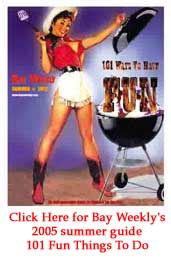

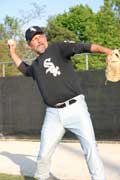
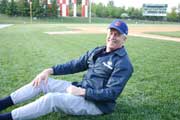
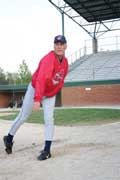
 About the Author
About the Author